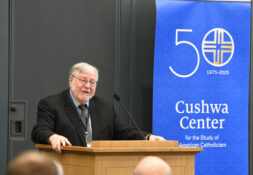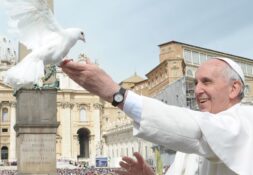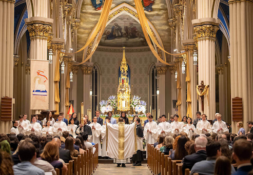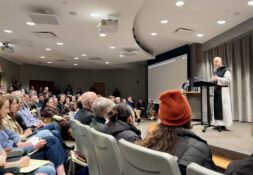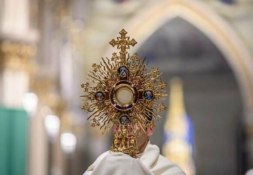The American Church is facing a compounding shortage of clergy, which many suggest can only be fixed by extending Holy Orders, particularly ordination to the diaconate, to women. Notre Dame has recently entered the global conversation on this contentious issue. In both a summer article in Notre Dame Magazine and a September panel hosted by the Department of Theology and the Cushwa Center for the Study of American Catholicism, pundits argued that women belong in the ordained diaconate.
The Church teaches, however, that Holy Orders—a single sacrament in the three ‘degrees’ of diaconate, presbyterate, and episcopate—may only be conferred on men. Pastoral concerns cannot supersede this truth. Thus, there can be neither a ‘call’ nor sacramental ordination to the diaconate for Catholic women.
Though the total number of Catholic priests in the United States has decreased considerably over the past 30 years, the number of Catholics on parish rolls has increased.
Anna Keating, a columnist, woodworker, and Program of Liberal Studies alumna, recognized that this shortage is a problem during her September 26 lecture:
“I think about all the people during COVID who died without even a phone call from their parish priest, let alone receiving the Anointing of the Sick or Viaticum. And what a scandal that is—how we just kind of folded in terms of giving people care during a really scary and challenging time. So yes, there is a need for more people to do that work—for more deacons.”
It is certainly true that vast swaths of Catholics were largely underserved by the American Church during the spring and summer of 2020 and beyond. But it’s not all bad news. Keating has someone in mind who can fix this problem:
“In my parish in Colorado Springs, [there’s] a woman named Catherine … She takes Communion after Mass to dozens of elderly people, many of them younger than she is. She’s the person who washes the vessels. She’s the person who sews the altar linens, she’s the person who teaches First Communion … Catherine is already doing diaconal work. She is already a deacon. We just haven’t named her as a deacon.”
In a summer 2022 article in Notre Dame Magazine: Callings Unanswered, Keating raises the question, “Might not some … women be called to be deacons?” Her answer is clear from a ‘witness’ she gave to Discerning Deacons, an organization that promotes the cause of female diaconal ordination: “Women should be trained as deacons without delay to ensure that no parish is underserved. We have prayed for an increase in vocations. God has answered our prayers.”
Are some women called to the diaconate? The question is not so easily answered. It is fundamentally a theological question as it regards the substance of the sacraments.
In Ordinatio Sacerdotalis, Pope St. John Paul II decisively declared: “The Church has no authority whatsoever to confer priestly ordination on women … this judgment is to be definitively held by all the Church’s faithful.” Notably, this document names only the priesthood, not the diaconate or the episcopacy. Yet its teaching applies to all three degrees of the sacrament.
In Pius XII’s Sacramentum Ordinis and in Vatican II’s Lumen Gentium, the Church affirms that there is one sacrament of Holy Orders in three degrees: the diaconate, presbyterate, and episcopacy. Relying on these magisterial teachings on the unity of Holy Orders, Gerhard Cardinal Müller, former Prefect of the Congregation for the Doctrine of the Faith, writes in Priesthood and Diaconate: “There can be no reasonable doubt that the degree of the sacramentally ordained deacon is also intended in Ordinatio Sacerdotalis.” Thus, he concludes: the “praxis Ecclesiae [‘tradition of the Church’] of conferring Holy Orders only on baptized males is a decree of divine law.”
Phyllis Zagano, an adjunct professor of religion at Hofstra University and papal appointee to the 2016 Pontifical Commission for the Study of the Diaconate of Women, spoke alongside Anna Keating at a recent event on campus. Against the former prefect of the CDF, she asserted that there is no doctrinal or theological barrier which precludes the extension of Holy Orders to women.
Responding to questions over email, Zagano told the Rover: “Today, some say that because a woman cannot be ordained priest, neither can she be ordained deacon. But there is historical, liturgical, and epigraphical evidence of women sacramentally ordained as deacons.”
Indeed, there is ample historical evidence of women called diakonoi or diakonissai ministering to women (mostly in extra-liturgical roles) in the early Church. Scholars argue about the meaning of the historical evidence, but one thing is clear: whether any of these women were sacramentally ordained is a theological, not a historical question. Even should there be ample evidence of ceremonies resembling ordination conferred on women in the early Church, the historical record cannot, in principle, answer the question of whether any woman has validly received Holy Orders. Neither the liturgical-historical record nor ancient epigraphs are decisive authorities.
Furthermore, the called-for ‘restoration’ of the female diaconate restores little from the early Church. The historical record shows that diakonissai ministered predominantly to women and rarely assisted in public liturgies. In her response to the Rover, Zagano conceded: “It is impossible to say that women deacons performed any or all liturgical tasks during the Mass throughout the history of the Church.”
As the International Theological Commission concluded in a 2002 document on the question of women and the diaconate: “The deaconesses mentioned in the tradition of the ancient Church—as evidenced by the rite of institution and the functions they exercised—were not purely and simply equivalent to the deacons.” Cardinal Müller, one of the document’s authors, notes in the aforementioned book: “deaconesses … certainly were not women who had received a sacrament ordaining them to the diaconate.” Thus, he concludes: “There can be no question of a ‘re’-introduction of a ministry for deaconesses that was ‘originally’ sacramental.”
Conferral of Holy Orders on women, in any of its three degrees, would cause a rupture with magisterial teaching on the unity of the sacrament and an innovation unknown in the history of the Church. Any attempt to ordain a woman to Holy Orders in the Catholic Church is an act which, by its very commission, places one outside of the Church, as reaffirmed by Pope Francis’s 2022 emendation to the Code of Canon Law: “Both a person who attempts to confer a sacred order on a woman, and the woman who attempts to receive the sacred order, incur a latae sententiae excommunication.”
In her teachings on the unity of Holy Orders and the male presbyterate, and in her punishment for their violation, the Church is clear: Holy Orders are validly conferred on men alone. No pastoral consideration, however grave, can nullify her teaching.
Paul Howard is a junior in Medieval Studies from Kinderhook, New York. Though he hails from the hometown of the nation’s eighth president, he knows precious little about Martin Van Buren. If you’d like to teach him about ‘Old Kinderhook,’ he can be reached at phoward2@nd.edu.
Photo Credit: Artwork from a recent Facebook post by the Vatican’s synodal office. https://www.facebook.com/synod.va/photos/pcb.5619549994793216/5619549054793310
